Speaking in low voices and idly watching their fishing lines, a handful of men and women mingle on a secluded pier at the southern tip of Texas. Drivers rush past on the highway above, east toward the discount shops and beach bars of Port Isabel and South Padre Island, or west to the shrimp shacks and shipbreakers at the end of the Brownsville Ship Channel. Here, in between, are acres of wetlands, the tidal flats of the Laguna Atascosa National Wildlife Refuge, where a cast of songbirds and raptors shuffles in and out with the seasons. A quarter-million ducks stop by every November. There’s also a population of ocelots, small enough to count, driven in by encroaching development.
Soon, this pier could sit at the heart of a great new industrial district, the likes of which the Rio Grande Valley has never seen. Sprawling facilities will receive natural gas from the Eagle Ford Shale, convert it to liquid form and ship it to Latin America, Europe and Asia, where it commands a higher price. Five liquefied natural gas (LNG) exporters have lease agreements here on the ship channel. Three of them, including Annova LNG, have filed plans with federal regulators. Annova wants to build its terminal just across the channel from this pier. Tankers capable of holding 40 million gallons of LNG would chug in from the Gulf, ease into a dock and fill up from storage tanks the size of tall buildings.

It’s a tantalizing prospect to the Valley’s business boosters, but the plans have drawn resistance from environmentalists and nearby residents, many of whom work in businesses that depend on tourists looking for unspoiled beaches. The “Save RGV from LNG” movement secured anti-LNG resolutions from the city councils of South Padre Island, Port Isabel and others by offering a simple, powerful vision. Look around, the activists said, do you want this to be another Corpus Christi? The resolutions were sternly worded but couldn’t do much to block the project. Last summer, Annova came to the Point Isabel Independent School District, which includes Port Isabel and South Padre Island, to ask for a $120 million tax break for its new terminal. So the activists made their case to the school board, too — but this time, as they learned, the stakes were much higher.
Property taxes are the largest source of funding for Texas public schools, and big industrial projects can add lots of new money to the school system quickly. Annova’s LNG terminal alone would be worth more than the tax base of one-quarter of Texas school districts. Companies pay most of their tax bill to the local school districts. For certain big projects, though, districts can forgive most of that sum using the Texas Economic Development Act, a 15-year-old program that’s often known by its place in the tax code, Chapter 313. That program actually makes it worthwhile for school districts to give away millions in tax revenue.
Under the law, if a school district grants a tax break for a desirable new project, the state is obliged to cover the difference. The cost of the deal comes out of the state budget. In its application to Point Isabel ISD, Annova said its terminal would be valued at $1.4 billion, but wanted the school district to pretend for the next 10 years that it was worth just $25 million. The tax break, Annova told the district, would be “a key component” in its decision to build. In fact, as local activists learned, the whole point of the Chapter 313 program was to lure business to Texas that might go elsewhere. If the school board rejected Annova’s deal, maybe the company really would pack up and leave. The school board vote, then, wasn’t going to be just another sternly worded resolution — it could be, locals hoped, the Achilles’ heel that could kill the project for good.
Residents knew they had momentum on their side, having won over so many other local officials. But as they had recently learned, schools hardly ever say no to a Chapter 313 deal. No district had ever rejected one this big. In fact, the program is built to encourage schools to give away the state’s money. Schools have no incentive to reject a deal, and often gain millions by handing out tax breaks.
It was a rainy night in mid-September when the board met to vote. “Everybody kept saying, ‘It’s a done deal, don’t even bother showing up with your signs,’” recalls Port Isabel resident Maria Galasso, who has been a leading opposition voice. But a crowd of residents turned up to make their case against the deal. “We all went. It was a full house,” Galasso says. After hearing from the residents, and one executive from Annova’s parent company, the school board members retreated behind closed doors to debate, leaving the crowd in suspense.

In most cases, Chapter 313 deals are both a windfall for companies and a way for school districts to turn a neat profit. When districts sign away millions in corporate tax breaks, the state of Texas pays them back and lets them negotiate side deals with the company worth millions more. The rationale behind these generous terms is to lure big capital-intensive projects to Texas when corporate honchos are considering other states. Companies must pledge to create a certain number of high-paying jobs, and claim that the tax break is “a determining factor” in their decision to build in Texas.
The scale of Chapter 313 dwarfs its better-known counterparts, the Texas Enterprise Fund and Emerging Technology Fund. Those two programs came under scrutiny in recent years as reporters and legislators found evidence that the governor had used them as slush funds for his friends. But at least those programs had a limit. Since 2003, the Legislature has spent $781 million from the two funds, which is $43 million less than Chapter 313 will cost the state in the next two years. Next year, the state will give away enough money in the program to pay for 50,000 students’ education. Chapter 313 is limitless, and each year the price tag runs higher. From 2002 to 2014, Texas schools committed to tax breaks that will hoover $5.5 billion from the state’s budget — more than the Legislature cut from public education during the recession. Deals signed in the last two years have driven the lifetime cost of the program above $7 billion, with no signs of slowing down. Recent applications awaiting approval — if history is any judge, nearly all of these will be approved — represent another $979 million. The program has been more popular than its creators ever imagined.
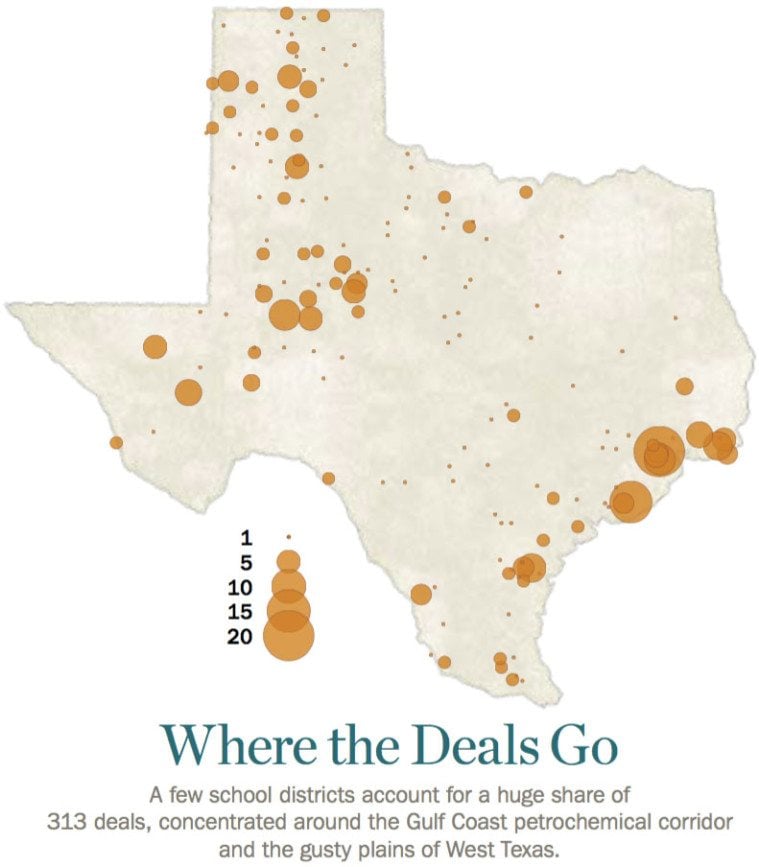
An Observer review of more than 360 deals suggests that much of this money was handed to projects that would have come to Texas anyway or couldn’t have been located anywhere else. Some companies won incentives even after they announced they were building in Texas. As a job creation program, Chapter 313 has been incredibly costly too — as of 2013, each job credited to a 313 project cost the state $350,000, well more than any other program the state runs. The Texas Enterprise Fund, which was also created with the twin goals of luring new jobs and economic investment to the state, cost just $3,737 per job, according to an audit that same year. With another budget crisis looming for the state, hardly anyone in Austin is watching as corporations add more zeroes to this blank check. The state comptroller’s office, which shares oversight with school districts, has signed off on all but seven of the 337 applications it has received since 2010, when the law first required posting them online. Of those seven, four reapplied and three were subsequently approved; the last is still under consideration.
The comptroller and school districts also share responsibility for overseeing the deals once they’re signed, though they both rely on companies to self-report their performance. Since 2010, comptroller records show just one instance where a company had faced a penalty for failing to deliver on its promises — a $187,000 fine in October 2015 for pipe manufacturer TPCO America for creating just 15 jobs, and not the agreed-upon 40. The fine was equal to what the company would have owed without a 313 deal in place. In other words, it faced no extra penalty for defaulting on its agreement. At a time when the Legislature can spend months scrapping over $100 million for pre-K, when $55 million to air-condition Texas prisons is a nonstarter, corporations such as Exxon and Dow Chemical need only ask and Texas hands them billions.
The state’s largest corporate welfare program was born in 2001 out of a creeping fear that Texas was losing its competitive edge. For years, Texas had been a perennial finalist for the Governor’s Cup, awarded annually by Site Selection magazine to the state with the year’s most million-dollar development projects. But by 2000, Texas had dropped to 37th. Intel, complaining that property taxes here were too high, scrapped its plans for a billion-dollar chip plant in North Texas and went to New Mexico instead. Soon after, Texas lost out to Illinois in the nationwide race to land Boeing’s new headquarters. To avoid repeating these disgraces, Republican state Representative Kim Brimer hatched a plan to let schools offer property tax breaks to lure manufacturing, renewable energy and other prized industries.
The first project that benefitted from the law was neither a wind farm nor a big score from out of state. It was a new Dow Chemical factory in Freeport, which is a little like coaxing the Pope to Rome. Freeport has been a Dow company town since before World War II. The streets and homes in neighboring Lake Jackson were personally designed by Alden Dow. But because the company owned other real estate across the country, its application claimed that without a tax break from the local school district, it might choose to take its new business elsewhere.
That vague threat was all it took for Comptroller Carole Keeton Strayhorn to recommend the deal. Brazosport ISD would, for the next decade, tax the new $263 million plant as though it were worth just $30 million. The deal let Dow pocket $14 million. A Dow official called it “truly a win-win.”
It took some time for Chapter 313 to catch on — one superintendent remembers calling around to companies trying to spread the word about the program — but soon schools were signing 30 deals a year, and then 40, and then 50. The program’s cost to the state ran far beyond initial estimates. After a decade of Chapter 313, the Legislative Budget Board reported that the program now represented “a significant fiscal impact to the state that, in aggregate, is limitless.” But to true believers in the low-tax, pro-business gospel that dominates the Legislature, those worrywarts had it backwards — the high cost of the program was a sign of its brilliance, a testament to Texas’ uncanny ability to woo business from other states. In 2008, Amarillo Republican David Swinford, whose House committee oversaw the program, said that Chapter 313 was “why we’re so economically powerful in this so-called depression.”
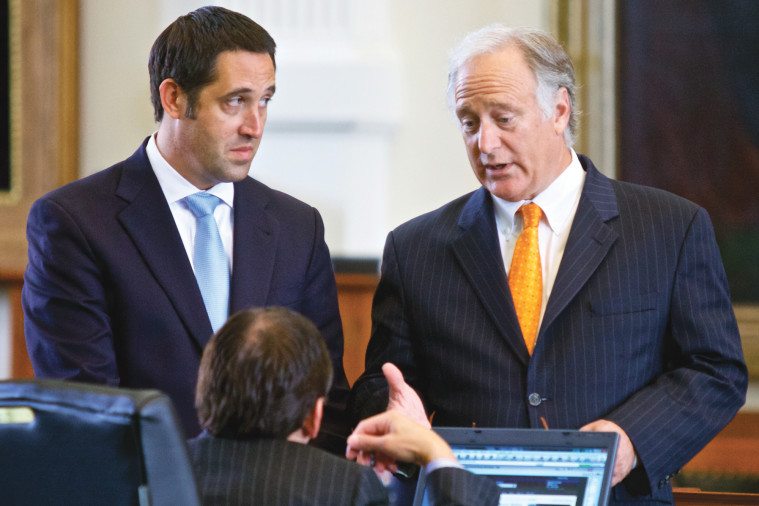
As the program grew, school districts began taking advantage of a provision that let companies offer supplemental payments to sweeten the deal. At first the payments were meant to help districts recoup the cost of reviewing the applications, but gradually school districts began playing hardball, cutting deals for up to half of the company’s tax benefit. Some of these bonus payments have topped $30 million. Best of all for the schools, the payments go directly to their bank accounts or to nonprofit foundations that support their schools.
THE FIRST PROJECT THAT BENEFITTED FROM THE LAW WAS NEITHER A WIND FARM NOR A BIG SCORE FROM OUT OF STATE. IT WAS A NEW DOW CHEMICAL FACTORY IN FREEPORT, WHICH IS A LITTLE LIKE COAXING THE POPE TO ROME.
An analysis of the program’s records shows that two-thirds of the districts with 313 deals are property-wealthy. Under Texas’ “Robin Hood” law, any new tax money they raise must go to a poorer school district instead. Supplemental payments let them sidestep that system. Some district officials have become savvy negotiators, demanding a bigger cut as a signing condition, like college football recruits holding out for a new Mercedes. Since 2010, these supplemental payments have been capped at $100 per student per year, which has cut down on the most extravagant bonuses, at least for smaller districts. In Chapter 313 deals on the books so far, payments to schools total around $1 billion.
Those kickbacks are a powerful incentive for districts to sign. Yet the law also leaves them with the primary oversight for making sure companies hold up their end of the bargain. Even without this conflict of interest, the law has put school districts — often rural ones with tiny administrative staffs — in the position of overseeing multinational corporations.
Take, for instance, the promise of luring high-paying jobs to Texas. Brimer, the program’s author, once hoped to require 100 high-paying jobs as a condition of a deal. By the time his bill was passed in 2001 that number shrank to 25 jobs — and just 10 in rural areas. But even that target was too high for some companies, particularly wind farms that don’t employ many people. Lawmakers settled on a simple solution: Districts can waive the job requirement entirely. The Observer’s review of program records shows that in more than 150 of the agreements on the books today — around half — companies don’t even pledge to deliver 10 jobs. Seven deals promise zero jobs.
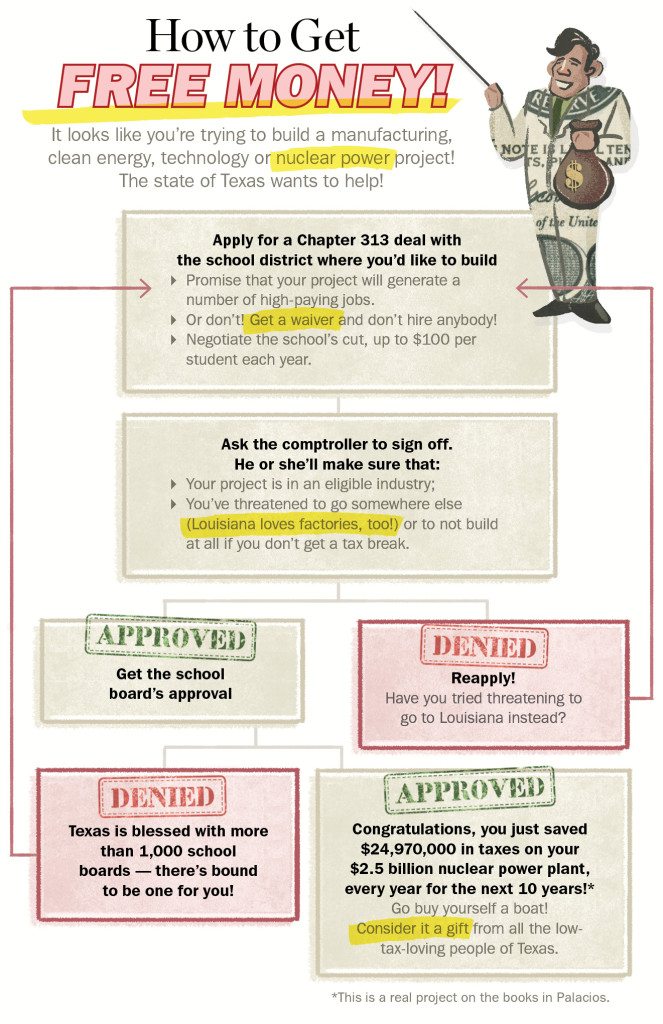
Perhaps none of that would matter if the state vigorously ensured that Chapter 313 was needed to bring investment to Texas. But many companies hardly even bother to maintain the pretense that they might go elsewhere. In December 2012, Beaumont ISD gave Pandora Methanol an incentive deal worth $5.6 million to refurbish a chemical factory it had bought four months prior. In 2012, the East Texas Electric Cooperative won a 313 deal for a wood-burning power plant with an application noting that they could potentially build “anywhere with a good supply of woody biomass” but had, following an exhaustive search of sites in East Texas, decided to build in East Texas.
In 2012, Site Selection magazine paraphrased Freeport LNG CEO Michael Smith — whose company holds three 313 agreements with Brazosport ISD, and is applying for a fourth — saying that tax credits “were not a factor in the site decision.” But he has been glad enough to hold on to the $375 million those tax breaks saved his company. Smith’s company has also announced plans for an export terminal near Annova’s site on the Brownsville Ship Channel, but hasn’t applied for a 313 deal. “The reality is,” Smith said of the Brownsville project, “there is only a very limited number of ports with a deep enough channel that had all the necessary requirements.”
And then there’s Bovina, a Panhandle town whose economy is largely dependent on animal feed plants run by Cargill. In June 2012, Cargill announced it was building a new plant in town, employing 37 full-time workers to make its sweet bran animal feed. Their press release came complete with a quote from Mayor Frank Gonzalez, who was “extremely pleased that Cargill has chosen Bovina for this investment.” Four months later, in October, Cargill applied for a 313 agreement worth $2.2 million, not even pretending to have considered sites in other states, only “various locations in Texas.” The jobs created at the sweet bran plant, at least, have paid off. A team of plant employees took first place last year in the nearby Friona Cheeseburger Festival.
The Observer’s review of program records shows that in more than 150 of the agreements on the books today — around half — companies don’t even pledge to deliver 10 jobs. Seven deals promise zero jobs.
It is exceedingly difficult not to get a 313 deal. If you’ve got a new factory or wind farm and you’d prefer to keep that $20 million in taxes for yourself, the toughest test you’ll face will come from Comptroller Glenn Hegar’s office, where analysts will check whether getting the tax break is — in the words of the law — “a determining factor” in your decision to build in Texas. Not “the determining factor,” of course — you’ve just got to appreciate the help Texas is giving. Companies still manage to run afoul of that test. In three cases the comptroller decided that the projects weren’t eligible for Chapter 313 tax breaks, but school districts approved them anyway and the state had to pick up the tab. (The law has since been changed to prevent districts from overriding the state.) In other cases, companies that failed to pass the “determining factor” test have reapplied, and won, with cosmetic changes to the language. In December 2014, for example, Denver-based Solar Prime applied for a deal to build a solar array in West Texas, but wasn’t forceful enough in its wording for the comptroller’s taste when it wrote that the incentive would “improve the economic viability of the project.” Six months later, Solar Prime came back saying it now “required” the tax deal. That time, the comptroller’s office approved it.
There are not many adversarial relationships to prevent the state from spilling public money back into the bank accounts of those who need it least. Two state audits have noted the weakness of relying entirely on companies’ self-reported information. Session after session, a few lawmakers have proposed reining in Chapter 313. Brenham Republican Senator Lois Kolkhorst has proposed putting a cap on the program’s cost. Austin Democrat Senator Kirk Watson has called for stronger analysis of whether the deals make financial sense. They have found little enthusiasm from other members. Chapter 313 was initially only supposed to last five years, through 2007. Now it won’t expire until 2022.
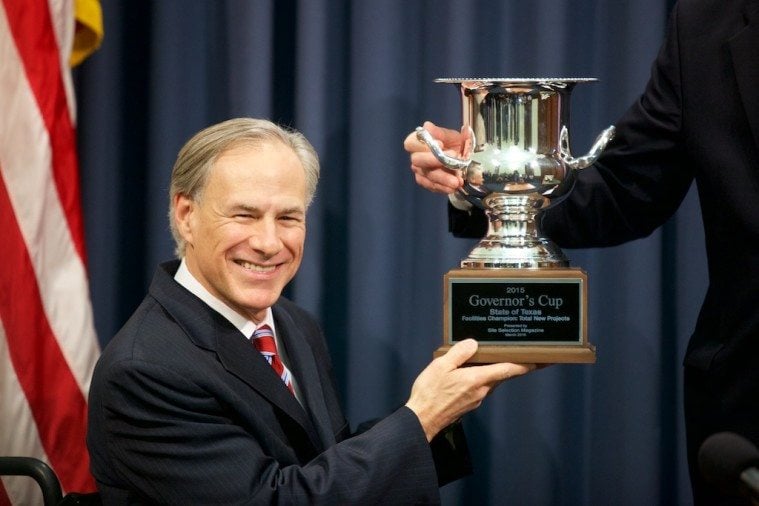
Since the 1980s, states have relied on incentive programs as economic development tools. Some states are far more generous than Texas. Louisiana, for instance, offers 100 percent tax abatement deals for some projects, which developers can claim after they’ve begun construction. More recently, though, states including Michigan and Illinois have made reforms to ensure they’re not needlessly handing over public money. “States need a reasonable estimate of how many of these businesses came as a result of the incentive,” says Josh Goodman, a Pew Center analyst who tracks incentive programs. Often, he says, states mistakenly assume that every project in an incentive program would have gone elsewhere without it.
But the way that 313 is set up, it’s “truly unknowable” how many companies were actually enticed by the incentive, according to Center for Public Policy Priorities analyst Dick Lavine. “There’s plenty of reasons to think that most of the projects would’ve come for other reasons.” Good roads, affordable housing and even a well-funded school system often count for more, he says, than a $100 million tax break.
“The burden of proof ought to be on those who say ‘Let’s have this program,’” says Watson, who supports incentives in principle but has argued in vain to reform Chapter 313. “If you favor these kinds of programs, you have a special obligation to show they work.”
Last session, the Legislature even tried to expand the program with a bill that would have cost an extra $50 million every year. Governor Greg Abbott vetoed it, writing that “while the program may sometimes have a positive impact on local economic development, serious concerns exist about its oversight, its transparency, and its value to the taxpayers.”
Still, Chapter 313’s supporters, including some school administrators, see it as a key ingredient in the “Texas Miracle.” Greg Poole, a school superintendent who enthusiastically supports Chapter 313, recalls a question he once put to a senator who was critical of the program. “Do we want to risk the economic success of Texas on a hunch?” he asked. “And what if you’re wrong?”
East of Houston along Interstate 10 sits Barbers Hill ISD, named for an underground salt dome that was home to a rich supply of oil in the 1930s. Since the district’s first deal in 2009, with the oil and gas firm Enterprise Products, it has signed 22 more. No other school district has more Chapter 313 agreements. Barbers Hill ISD’s tax base has doubled since 2011, from $3.4 billion to nearly $7 billion. Home to 5,000 students, Barbers Hill employs two former lawmakers — Craig Eiland and Rob Eissler — to lobby on its behalf in Austin.
At a time when the Legislature can spend months scrapping over $100 million for pre-K, when $55 million to air-condition Texas prisons is a nonstarter, corporations such as Exxon and Dow Chemical need only ask and Texas hands them billions.
The schools, and most of the rest of Mont Belvieu, sit a few miles from the salt dome, which was once the heart of the town and has, since the 1930s, been overtaken by the oil and gas industry. As drillers pulled oil from around the salt dome, and other firms began storing gas in its underground caverns, residents became frequent victims of large and small disasters. Major explosions killed people in town and smaller leaks ignited laundry rooms in houses or gave off strange smells. Gradually folks moved away. Under the terms of a legal settlement in the 1980s, companies bought out residents’ homes around Barbers Hill and the town moved east. Now the two faces of Mont Belvieu sit a few miles apart — homes and schools to the east, heavy industry to the west, each one feeding the other, each with plenty of room to grow.
One peculiarity of the Chapter 313 program is that it casts rural school administrators as the middle-men in business negotiations between industry giants and the state of Texas. It can be an uneasy fit, but Greg Poole seems to relish the role. Along with the district’s chief financial officer, Becky McManus, he says, “I have sat across the table from some of the highest-ranking Exxon people you can possibly imagine, and we’ve stood toe to toe.” Poole says that the last few years have made him a believer. “Texas is where it’s at economically primarily because of these 313 incentives,” he said.

Poole is a seventh-generation Texan who was raised in the Panhandle in the days before wind farms were pouring millions into the local tax base. He knows what it’s like at schools without money. His district has been one of the most aggressive in the state in asking for companies to return a cut of the tax breaks to the schools.
“There’s people such as us that negotiate hard. I don’t apologize for that. These are schoolchildren,” he says. “Five years from now, we don’t want to look back and say that we left money on the table.”
Supplemental money from Exxon’s latest 313 deal is helping to pay for a new library next to the high school. The district also maintains a foundation, partially funded by payments from the 313 deals, that awards grants to help teachers innovate in the classroom. And every year the district still sends $11 million in “Robin Hood” payments to fund other school districts.
“We’re an outlier. Our economic wealth is coveted. We send millions to the state that we feel like is theft,” he says. The Chapter 313 law is meant to give Texas a competitive advantage over other states, but to Poole, the game is as much about out-maneuvering other Texas districts. Poole holds up his district’s recent deal with Exxon as an example. “They had a choice to place this in Brazosport, in Freeport, in Calhoun County,” he says. “What it’s all about is competing.” Poole sees Chapter 313 as one of the few ways he has left to raise money for his schools, and it’s a reasonable perspective. Funding for public schools is scarce and there is a strong incentive for districts to hold onto any money they can.
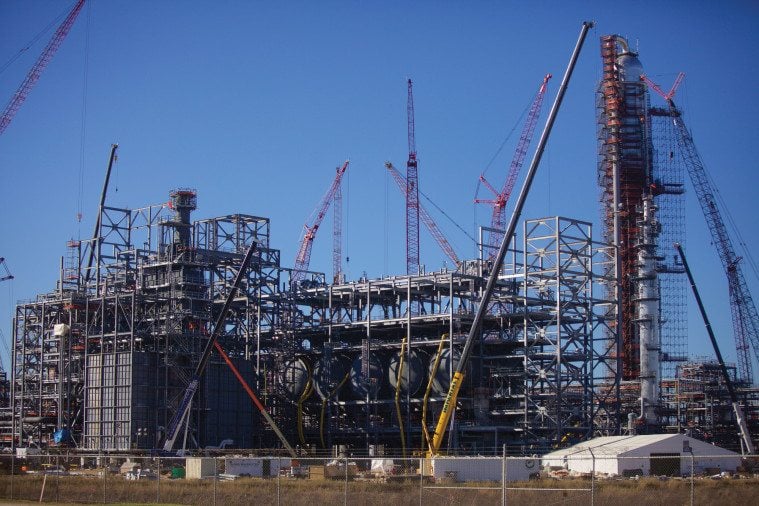
For most of its 15 years, Chapter 313 has been a closed system, a trapdoor in the state budget watched only by a handful of school administrators, consultants and employees in the comptroller’s office. There’s no reason anyone outside that circle would know when another $100 million handout gets signed. That’s what was so different in Port Isabel last fall: A group of residents angry about one deal, one out of more than 300 on the books today, brought some sunshine to the whole program. Their objective was to keep Annova out of their community, but in the process, they were able to test whether the company really needed a tax break.
When board members returned to announce their decision, the vote was unanimous: The district rejected Annova’s application. “The community has spoken,” one board member announced, “and we affirmed.” The crowd cried and cheered. One of them sent a poem to the local newspaper casting the victory in epic terms: “I was with that big group of villagers / When we finally wiped out the vampires.”
While some board members shared the activists’ environmental concerns, board president Mickey Furcron says that, for him, the vote was a matter of expediency. He didn’t relish the thought of hearing an environmental horror story every time he opened a new board meeting. A few million wasn’t worth that much to the schools, he said, and anyway, even if he disagreed, “we have a responsibility to represent the wishes of our constituents.”
If the deal truly was necessary to bring Annova to town, local residents hoped, then the board’s rejection would keep the company out. But within a day, Annova announced that even without the break, it planned to press ahead with its terminal on the ship channel. For once in the life of the Chapter 313 program, a community dared to call a company’s bluff. As it turned out, Annova didn’t need the handout after all.




